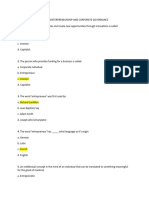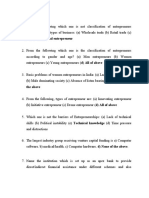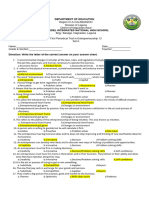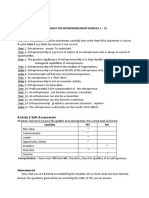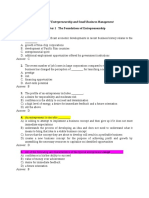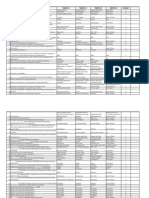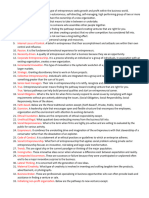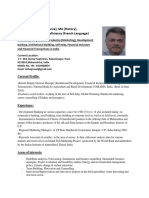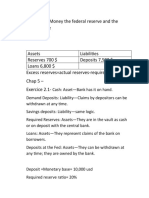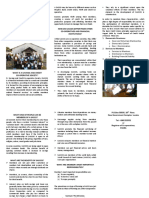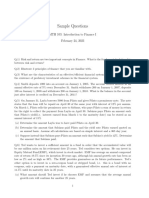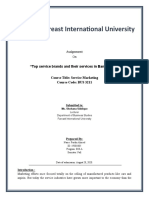EDS121 2015 Mid-Semester Past Questions
Uploaded by
omozokpea.miracleEDS121 2015 Mid-Semester Past Questions
Uploaded by
omozokpea.miracleEDS121 2015/2016 OMEGA MID SEMESTER
EXAMINATION
1. …………………… Is the dimension of entrepreneurship that focus
on the series of task that must be carried out to achieve certain set
goal(a)Process dimension (b) behavioural dimension (c) outcome
dimension (d)Task dimension
2. Idea generation, writing of a business plan, engaging in feasibility
study and writing feasibility report are examples of (a) process
activities (b) behavioural activity (c)planning activity (d)business
activities
3. One of the following is not a dimension of entrepreneurship (a)
none of the mentioned (b) process dimension (c) behavioural
dimension (d) outcome dimension
4. The process by which individuals pursue opportunities without
regard to resources they currently control is called Entrepreneurship
as (a) process (b) behaviour (c) outcome (d) task
5. …………. defined entrepreneurship as the process by which
individuals pursue opportunities without regard to resources they
currently control (a) Stevenson and Jarillo (b) Hisrich and Peters (c)
Stevenson and Peter (d) Jarillo and Peter
6. a way of thinking, reasoning, and acting that is opportunity based,
holistic in approach and leadership balanced is Entrepreneurship as
(a) behaviour (b) process (c) outcome (d) none of the mentioned
7. ………………. defined entrepreneurship as a way of thinking,
reasoning, and acting that is opportunity based, holistic in approach
and leadership balanced (a) Timmons and Spinelli (b) Stevenson and
Jarillo (c) Hisrich and Peters (d) Timmons and Jarillo
8. ………dimension of entrepreneurship is focused on the character
tics and roles of individuals who are entrepreneurs(a) behaviour(b)
process (c) outcome (d) task
9. the introduction of new economic activities that leads to change in
the market place' is Entrepreneurship as (a) outcomes (b) behaviour
(c) process (d) task
10. ……………defined entrepreneurship as the introduction of new
economic activities that leads to change in the market place (a)
Simon(b) Stevenson and Jarillo (c) Hisrich and Peters (d) Timmons
and Jarillo
11. ………dimension of Entrepreneurship focuses on the results of
entrepreneurship as a process or set of behaviours (a) outcomes (b)
behaviour (c) process (d) task
12. One of the following is not a type of entrepreneurial classification
based on role identity (a) Oriental identity (b) Artisan identity (c)
Managerial identity (d) Classical identity
13. ……………. identity of entrepreneur sees their role as a means of
attaining personal independence and freedom, especially in areas of
hiring staff, financial arrangement, and decision making (a) Artisan
(b) Oriental (c) Managerial (d) Classical
14. One of the following Entrepreneurs is driven by freedom and
independence (a) Artisan (b) Oriental (c) Managerial identity (d)
Classical identity
15. One of the following Entrepreneurs has the responsibility of
efficiently and effectively utilizing resources for maximum financial
returns (a) Classical (b) Artisan identity (c) Managerial identity (d)
Classical identity
16. One of the following Entrepreneurs is driven by decision making
ability (a) Classical (b) Artisan (c) identity Managerial identity (d)
Classical identity
17. One of the following Entrepreneurs is driven by need for growth,
security and continuity (a) Managerial identity (b) Classical identity
(c) Artisan identity (d) Oriental identity
18. One of the following Entrepreneurs is require formal education
and prior job experience (a) Opportunistic Entrepreneur (b) Craftsman
Entrepreneur (c) Oriental Entrepreneur (d) Classical entrepreneur
19. One of the following is not conscious of growth and do not plan
for the future (a) Craftsman (b) Opportunistic (c) Oriental
Entrepreneur (d) Classical entrepreneur
20. One of the following is not a challenge to Entrepreneurs in
Nigeria (a) Eradicate bureaucracy (b) poor financial base (c) low
entrepreneurial skills (d) inadequate infrastructural base
21. one of the following is not a challenge to Entrepreneurs in Nigeria
(a) Catch them young approach (b) low productivity (c) Poor
management (d) poor employee relation
22. One of the following will not aid the development of
Entrepreneurial consciousness in Nigeria (a) none of the mentioned(b)
Catch them young approach(c) Eradicate bureaucracy (d) Celebrate
Nigerian made products
23. ………………...is the assessment of external uncontrollable
variables that may impart the business plan (a) Environmental
analysis (b) Environmental scanning (c) Environmental diagnosis
(d) none of the mentioned
24. Through……………………. businesses can determine
opportunities and threats (a) Environmental analysis (b)
Environmental scanning (c) Environmental diagnosis (d) none of
the mentioned
25…………defined Environmental diagnosis is the process of making
managerial and strategic decisions by assessing the significance of the
data (opportunities and threats) in the environmental analysis
(a)Glueck (b)Hisrich (C)Robbins and Coulter (d)Stevenson and Jarillo
26………….is defined as the screening of large amount of
information to anticipate and interpret changes in the environment.
(A) Environmental Scanning(B)Environmental
analysis(C)Environmental diagnosis(D)none of the mentioned
27When scanning the environment, one of the following should be
considered(A)all of the mentioned(B)Economic factors(C)supplier
factors(D)Social factors
28One of the following should be not be considered when scanning
the environment(A)none of the mentioned(B)Government
factors(C)Social factors (D)Competitor factors
29Devaluation of naira is an example of…………. (A) Economic
factor(B)Demographic factor(C)Political Factor(D)Business factor
30Change in leadership is an example of……………. (A)
Government factor(B)Economic factors(C)Political Factor(D)Social
factors
31. good reputation, resources, assets, people, experiences are
examples of (A) strength(B)weakness(C)opportunity(D)threats
32. excellent distribution network, skills, public image, research and
development are examples of opportunities(A) FALSE(B)TRUE
33. low commitment of workers, weakness in skills, and poor
financial standing are examples of threats(A)FALSE(B)TRUE
34.economic boom, favourable demographic shifts, and arrival of new
technologies are examples of (A) opportunity
(B)strength(C)weakness (D)none of the mentioned
35.new technology, loss of key staff, lack of sustainable financial
backing, and obstacles in licensing new business are all examples of
weakness(A)FALSE(B)TRUE
36.Is it true that demographic shifts, new competitors, and unexpected
shifts in consumer tastes are examples of threats?
(A)TRUE(B)FALSE
37. journal, government publications, books, newsletters, and annual
reports are examples of primary sources of information(A)FALSE
(B)TRUE
38. is it true that trade associations, suppliers, customers, and
government agencies are internal sources of information?
(A)FALSE(B)TRUE
39. is it true that company’s staff, database, reports and documents are
internal sources of information? (A)TRUE(B)FALSE
40. The advantages of SWOT analysis is all but one of the
following(A)it can be used to decentralize business plans,
competitors, market and products(b)it is flexible (C)helps to
discover firm’s distinctive competencies(D)Useful in developing
goals and strategies
41. pick the odd one out (A)commercial bank(B)merchant
bank(C)accepting and issuing house(D)investment bank
42.In United State of America, merchant bank is called……
(A)investment bank(B) accepting and issuing house(C)mortgage
bank (D)commercial bank
43.One of these is not a function of merchant bank. (A)none of the
mentioned(B)Credit Syndication(C)Portfolio Management(D)leasing
and finance
44. Eventful the organizer' is owned by (A)Yewande
Zaccheus(B)Arinola Adeniyi (C)Candy Agu(D)Tayo Ogunsanya
45. One of these Entrepreneurs is a lawyer(A)Yewande
Zaccheus(B)Arinola Adeniyi(C)Candy Agu(D)Tayo Ogunsanya
46.One of these Entrepreneur is the pioneer of event management in
Nigeria. (A)Yewande Zaccheus(B)Arinola Adeniyi(C)Candy
Agu(D)Tayo Ogunsanya
47. One of the following is a lesson from Yewande Zaccheus
(A)Business idea can be identified from what one does
naturally(B)Business idea can be identified from what one has money
to start(C)Business idea can be identified from what one studied in
school(D)none of the mentioned
48.One of the following Entrepreneur recommends that women
should develop good network(A)Yewande Zaccheus(B)Arinola
Adeniyi (C)Candy Agu(D)Tayo Ogunsanya
49.One of the following Entrepreneur recommends that women
should develop good financial record. (A)Yewande
Zaccheus(B)Arinola Adeniyi(C)Candy Agu(D) Tayo Ogunsanya
50.Venivici health club is owned by(A)Arinola Adeniyi(B)
Yewande Zaccheus(C)Candy Agu(D)Tayo Ogunsanya
51.Adpete is owned by(A)Candy Agu(B)Yewande
Zaccheus(C)Arinola Adeniyi(D)Tayo Ogunsanya
52.Party in a box limited is owned by(A)Candy Agu(B)Yewande
Zaccheus(C)Arinola Adeniyi(D)Tayo Ogunsanya
53.One of the following persons identified her business opportunity in
her room (A)Candy Agu(B)Yewande
Zaccheus(C)Arinola Adeniyi(D)Tayo Ogunsanya
54.Which of the following persons started a toy manufacturing
company? (A)Candy Agu(B)Yewande Zaccheus(C)Arinola
Adeniyi(D)Tayo Ogunsanya
55.One of the following identified Government Bureaucracy as a
major challenge to Entrepreneurs in Nigeria(A)Candy
Agu(B)Yewande Zaccheus(C)Arinola Adeniyi(D) Tayo Ogunsanya
56.WIMBIZ was established in (A)2002(B)2009(C)2012(D)2006
57.WIMBIZ is established for one of the following (A)act as catalyst
to elevate the profile of women in business(B)mentor women in
business(C)encourage women in business(D)all of the mentioned
58. one of the following person is the Chairperson of board of trustees
of WIMBIZ(A)Yewande Zaccheus(B)Arinola Adeniyi(C)Candy
Agu(D)Tayo Ogunsanya
59.Hangers and kicks is owned by(A)Tayo Ogunsanya(B)Arinola
Adeniyi(C)Candy Agu(D)none of the mentioned
60.…………………is a wholesale bank(A)Merchant
bank(B)Commercial bank(C)Central bank(D)Development bank
61.The first modern banking system came to West Africa in….
(A)1894(B)1904(C)1884(D)1914
62.…………………bank deals on medium to long term
loan(A)Merchant bank(B)Commercial bank(C)Central bank(D)
Development bank
63.…………………. bank receives deposits in form of fixed
deposits(A)Merchant bank(B)Commercial bank(C)Central
bank(D)Development bank
61…………………. bank provides finance for investments mainly
for corporate banks(A)Merchant bank(B)Commercial bank(C)Central
bank(D)Development bank
63. The first modern bank in Nigeria was called……. (A)Bank of
British West Africa(B)British Bank of Nigeria (C)British Nigerian
Bank (D)British West African Bank
64. West African Currency Board was founded in(A)Nov-12(B)Dec-
12(C)Oct-13(D)Oct-12
65……………….is the mobilization of funds from surplus unit to
deficit unit (A)Financial intermediation(B)Financial
devaluation(C)Cash movement(D)none of the mentioned
66…………………………is the medium of transferring purchasing
power(A)Financial instruments(B)armour tank(C)financial
rank(D)cash cow
67.One of the following is not a part of the Nigerian Banking
system(A)Insurance bank(B)Mortgage bank(C)Development
bank(D)none of the mentioned
68. pick the odd one out(A)Debentures bill(B)Treasury
bills(C)Treasury certificates(D)Commercial bill
69.pick the odd one out
(A)Certificates(B)Stocks(C)Shares(D)Debentures
70.One of the following is not controlled by CBN (A)none of the
mentioned(B)building society(C)money market(D)savings bank
71.One of the following is controlled by CBN(A)all of the
mentioned(B)Capital market(C)Commercial banks(D)insurance
You might also like
- EXTRATO ITAU UNICLASS (90 DIAS) - RENDA 30 MIL1No ratings yetEXTRATO ITAU UNICLASS (90 DIAS) - RENDA 30 MIL17 pages
- Chapter 1: Entrepreneurship: Evolutionary Development-Revolutionary ImpactNo ratings yetChapter 1: Entrepreneurship: Evolutionary Development-Revolutionary Impact29 pages
- GST 223, Q&a (Kadung Samuel For Sossa 001 2019)100% (1)GST 223, Q&a (Kadung Samuel For Sossa 001 2019)66 pages
- Mock MCQ Test: Subject: Entrepreneurship Development (Ed) Paper Code: Ms 207No ratings yetMock MCQ Test: Subject: Entrepreneurship Development (Ed) Paper Code: Ms 20712 pages
- Modibbo Adama University of Technology, YolaNo ratings yetModibbo Adama University of Technology, Yola3 pages
- Option 1 Option 2 Option 3 Option 4 AnswerNo ratings yetOption 1 Option 2 Option 3 Option 4 Answer7 pages
- Entrepreneurship and Innovation Tutor Marked Assignment Questions General InstructionNo ratings yetEntrepreneurship and Innovation Tutor Marked Assignment Questions General Instruction19 pages
- Sample-Test Bank Entrepreneurship Theory Process Practice 4th 4E 2No ratings yetSample-Test Bank Entrepreneurship Theory Process Practice 4th 4E 214 pages
- Business Management for Scientists and Engineers: How I Overcame My Moment of Inertia and Embraced the Dark SideFrom EverandBusiness Management for Scientists and Engineers: How I Overcame My Moment of Inertia and Embraced the Dark SideNo ratings yet
- Inclusive Business Market Scoping Study in the People's Republic of ChinaFrom EverandInclusive Business Market Scoping Study in the People's Republic of ChinaNo ratings yet
- Robert Niederman Trust Bank Statement Mar 24No ratings yetRobert Niederman Trust Bank Statement Mar 247 pages
- Group Product Surrender Request Form English 21102021No ratings yetGroup Product Surrender Request Form English 211020212 pages
- Introduction To Indian Financial SystemNo ratings yetIntroduction To Indian Financial System30 pages
- Digital Transformation of Financial Intermediation Opportunities, Challenges, and Regulatory ImplicationsNo ratings yetDigital Transformation of Financial Intermediation Opportunities, Challenges, and Regulatory Implications14 pages
- Arvidsson - 2013 - Consumer Attitudes On MobileNo ratings yetArvidsson - 2013 - Consumer Attitudes On Mobile22 pages
- ACCE 312 Financial Statement Formats - EngNo ratings yetACCE 312 Financial Statement Formats - Eng6 pages
- Chapter 25 Money The Federal Reserve and The Interest Rate Exercce 2.5No ratings yetChapter 25 Money The Federal Reserve and The Interest Rate Exercce 2.56 pages
- Annex VII Revised Claims Procedure PMJJBY - 17062021No ratings yetAnnex VII Revised Claims Procedure PMJJBY - 170620213 pages
- FEMA Compliances For A Person Issuing Foreign SecurityNo ratings yetFEMA Compliances For A Person Issuing Foreign Security10 pages
- AccountStatement - 12 NOV 2024 - To - 14 NOV 2024No ratings yetAccountStatement - 12 NOV 2024 - To - 14 NOV 20242 pages
- Iliana Ramos: 1349 Las Cruces Ct. Salinas CA, 93901 (831) 210-9376No ratings yetIliana Ramos: 1349 Las Cruces Ct. Salinas CA, 93901 (831) 210-93762 pages
- HDFC LTD Vs Ram Pal Garg On 14 June 2018No ratings yetHDFC LTD Vs Ram Pal Garg On 14 June 20189 pages




